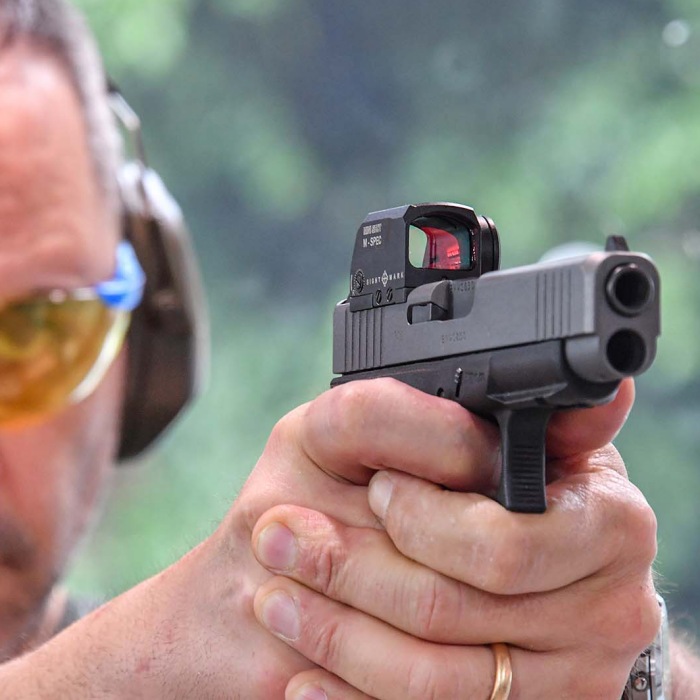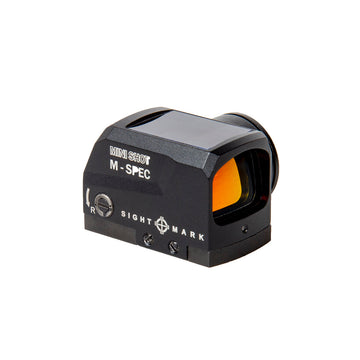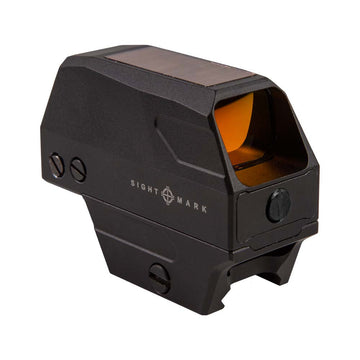Anyone who’s spent time on a square range knows how easy it is to get comfortable. You take your time, line up every shot, and maybe even chat with your buddies between magazines. But shooting with a red dot changes everything when it’s real—not a drill. A break-in at 3 a.m., a violent encounter in a parking lot, or a home invasion—none of that gives you time to breathe. No one knows how they’ll react when bullets start flying; training goes out the window, adrenaline takes over, and the only constant is chaos.
There are a lot of actions you can take under fire, but stopping to perfectly align your sights and assume a textbook shooting position is the wrong one. If you try to take your time when rounds are coming your way, you’re signing your own death warrant. There’s a reason old soldiers say, “No plan survives first contact with the enemy.”
That’s where the tools you choose—like a red dot sight—make all the difference. When chaos erupts and you’re shooting with a red dot from cover or a bad angle, you find your aiming point instantly. No fuss. No wasted motion. Just reaction and response.
Shooting with Red Dots from Unorthodox Positions
On a range, life is easy. You stand upright, build a perfect stance, and shoot at paper targets straight ahead. But that’s not how gunfights work. You’re ducking behind cover, shooting around car doors, through windows, under tables, or from inside a vehicle.
This is where the VTAC barricade comes in—a common training tool that simulates real-world obstacles. It forces you into awkward, uncomfortable shooting positions. Iron sights demand perfect alignment—front sight, rear sight, and target all in a straight line. But when you’re twisted behind a barricade or leaning around a corner, that’s not happening.
Shooting with a red dot eliminates that mess. The dot stays on the same focal plane as the target. You can crouch, lean, shoot weak-handed—if you can see the dot, you can hit the threat. No need for a cheek weld. No need to square up. Just act.
The Sightmark Mini Shot M-Spec M3 Solar is built for this. It’s compact, durable, and runs off both battery and solar power, so you’re never left with a dead optic. Its automatic brightness setting keeps the reticle crisp whether you’re outside in daylight or deep inside a hallway.
Why Red Dots Beat Iron Sights Under Stress
Shooting from awkward angles is where iron sights start to betray you. Your eye physically can’t focus on the front sight, rear sight, and target all at once—especially not when you're panicked, off balance, or ducking for your life.
Red dots simplify everything. You put the dot on the threat and press the trigger. That’s it. That’s the difference between shooting with a red dot and struggling with irons when the pressure’s on.

Using Red Dots from Cover or Concealment
Red dots let you shoot from cover with both eyes open and full situational awareness. That’s not fluff—it’s critical. When you’re leaning around a barricade or prone behind your car, iron sights become almost useless unless you’re perfectly aligned.
With a red dot, as long as you see the dot on the target—even through the edge of the lens—you’re good. The Sightmark Volta shines here, with solar + AAA battery redundancy and auto-adjusting brightness. It’s built for tight angles, no-warning situations, and sudden violence.
Shooting with a Red Dot Inside or Around Vehicles
Inside a car, everything is wrong. You’re seated, seatbelted, boxed in. The sightline is garbage. Glass reflects light. The angle’s off. Iron sights? Forget it.
Shooting with a red dot from inside a vehicle means you just raise the gun, find the dot, and shoot. No need to line up anything. The Mini Shot M3 Solar and Volta both excel here—bright enough to cut through reflection, small enough to fit any build, and reliable enough to trust with your life.
Competition and Training: Real-World Red Dot Skills
The same barricades you find in tactical matches—like 3-gun—are what train shooters to problem-solve in the moment. Shooting with a red dot gives you the confidence to move faster, take riskier angles, and adapt under pressure. The Sightmark Wolverine, with its six-year battery life and bombproof construction, lets you push those limits without worrying about gear failure.
The Bottom Line: Shooting with Red Dots Under Stress
Red dots aren’t trendy. They’re what law enforcement, military, and serious shooters use because they work. Shooting with a red dot means you’re not gambling on alignment or lighting—you’re focusing on the threat and delivering fast, accurate fire.
Still clinging to irons in 2025? You’re behind. Way behind.
Train how you fight. Shoot from cover. Use barricades. Get off the square range. If you’re serious about survival, about winning when it counts, stop treating red dots like an accessory and start treating them like the necessity they are.
Ready to make the switch? Check out the Sightmark Wolverine, Mini Shot M3 Solar, and Volta—and bring your shooting into the real world.
Frequently Asked Questions
What is the importance of shooting with a red dot sight in high-stress situations?
Shooting with a red dot sight in high-stress situations allows for rapid target acquisition and eliminates the need for perfect alignment, making it easier to react and respond quickly.
How does shooting with a red dot sight differ from using iron sights?
Shooting with a red dot sight eliminates the need for perfect alignment of front and rear sights with the target, allowing for more flexibility in shooting positions and scenarios.
What are some advantages of the Ultra Shot R-Spec Reflex Sight and the Mini Shot M-Spec M2 Solar red dot sights?
The Ultra Shot R-Spec Reflex Sight offers rapid target acquisition with customizable reticle options, while the Mini Shot M-Spec M2 Solar combines solar technology with battery power for extended operation, making them both reliable choices for various shooting conditions.
How can shooting with a red dot sight help in shooting from unorthodox positions?
Shooting with a red dot sight allows for easier shooting from unorthodox positions such as shooting around obstacles or from awkward angles, as the dot remains on the same focal plane as the target, making it easier to maintain accuracy.
What features make the Sightmark Mini Shot M-Spec M3 Solar red dot sight suitable for shooting from unorthodox positions?
The Sightmark Mini Shot M-Spec M3 Solar red dot sight is compact, durable, and runs off both battery and solar power, ensuring continuous operation. Its automatic brightness setting also keeps the reticle crisp in various lighting conditions, making it ideal for shooting from unorthodox positions.







